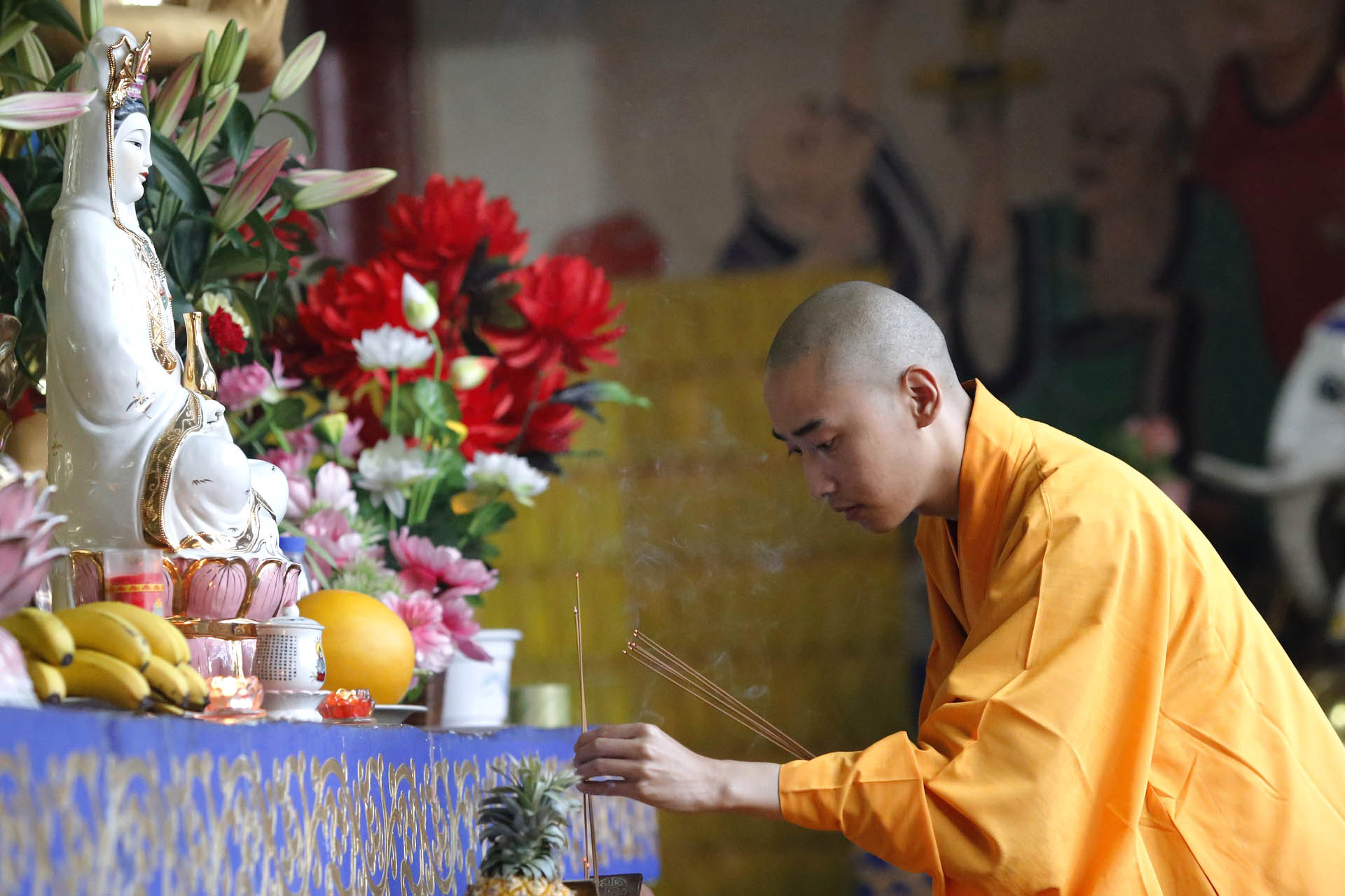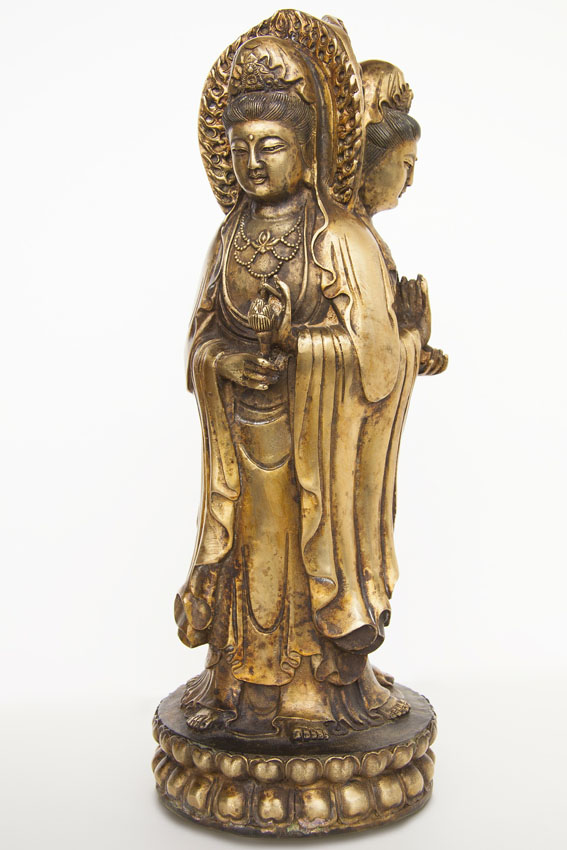Introduction:
Within Buddhism, Guān Yīn or Kwan Yin 觀音 is the Chinese name of Avalokiteshvara, the bodhisattva* of compassion, which in China is generally represented in feminine form. Guān Yīn is also a revered figure in Taoism as an immortal.
Her original name, Guān Shì Yīn 觀世音, can be translated as "The One Who Perceives the Sounds of the World", referring to Guān Yīn's ability to listen to the cries of all beings and come to their aid. This name was shortened due to the existing taboo of using the character shì 世, contained in the name of Emperor Tàizōng 唐太宗, Lǐ Shìmín 李世民.
In Tibetan Buddhism, Avalokiteshvara adopts the name of Chenrezig, and is reincarnated again and again in the figure of the Dalai Lamas. In Japan it takes the name of Kannon; It is also a female figure like Guān Yīn.
In China, Guān Yīn was represented in masculine form until at least the 10th century. In the Lotus Sutra (妙法蓮華經 Miào Fǎ Lián Huá Jīng), Avalokiteshvara is described as someone capable of taking any form. From the 15th century onwards, representations of Guān Yīn are generally female, possibly due to her association with compassion and benevolence.
Another of Guān Yīn's notable differences with the Indian Avalokiteshvara is that, in China, Guān Yīn was never associated with royalty as Avalokiteshvara was. It is possible that this was due to the fact that in China there was already an association of the figure of the emperor with a divine power, with him being considered as the Son of Heaven.
Guān Yīn was represented in masculine form until at least the 10th century.
The popularity of Guān Yīn in China is such that it is said that there is not a single home where she is not worshipped. So much popularity is, at least, curious. Until the appearance of Guān Yīn the idea of a universal saviour, who would answer the calls of those who needed it, was inexistent in China. The Taoist deities lived away from society and the human world, in search of immortality in union with nature. Although Buddhism was a foreign religion, the new figure of Guān Yīn was especially attractive, since it could provide spiritual peace while alleviating material misfortunes. There was a void in the Chinese pantheon that Guān Yīn came to fill.
However, after the acceptance of the figure of Guān Yīn by the Chinese people, it underwent a transformation with respect to the Indian Avalokiteshvara, just as all Buddhism suffered an adaptation to the Chinese mentality.

Chinese monk offering incense before an image of Guān Yīn.
The indigenization of Buddhism in China:
During the Hàn 漢 dynasty (206 BC - 220 AD), the Indian and Central Asian monks who travelled along the Silk Road introduced the Buddhist religion in China. At first, the Chinese did not understand Buddhism well and added the Buddha to the Taoist pantheon, where he was worshiped alongside Lǎo Zǐ 老子 and Huáng Dì 黃帝, the Yellow Emperor. When in China people begins to artistically represent the Buddha, he adopts the same form as another Taoist deity, Xīwángmǔ 西王母, the Queen Mother of the West.
The introduction of the idea of reincarnation was a new problem, since it was an entirely new concept for Chinese thought. The only way in which the Chinese could make this concept their own was by assuming the existence of an eternal soul that transcended death, an idea at all points contrary to the Buddhist concept of anātman or absence of self.
As a way of making Buddhism familiar with the local culture, the Chinese looked for ideas already existing in Taoism to which they could associate the new ones, thus provoking a transformation of the original Indian Buddhism. It should be noted that in this early period, the most popular sutras did not mention the figure of Avalokiteshvara.
After the fall of the Hàn dynasty in the 3rd century, Buddhism began to take root in China, and to compete with Taoism for imperial patronage and the support of the people. The most popular ideas or formulas of one religion were copied by the other, and vice versa. Thus a process of exchange and mutual contamination between the two religions took place. Taoism adopted for some of its deities the most attractive characteristics of the bodhisattvas, like the ability to ensure the salvation of all beings.
During the Suí 隋朝 (581-618) and Táng 唐朝 (618-907) dynasties the first typically Chinese Buddhist schools were developed: the Tiān Tái 天台宗, Huá Yán 華嚴宗 schools, the Pure Land Buddhist school and the Chán school 禪 (Zen) are the exclusive result of Chinese thought. These schools gave the highest authority to the Lotus Sutra, the Huá Yán Sutra and the so-called Pure Land Sutras, in which Guān Yīn or Avalokiteshvara has a preeminent role. In this way, coupled with the growing popularity of these indigenous schools in China, the popularity of Guān Yīn increased in the same way. In the Táng dynasty, the popularity of Guān Yīn, along with that of the Buddha Amithaba (Āmítuó Fó 阿彌陀佛), had surpassed that of Sakyamuni Buddha himself.
From early on, there was a tendency towards religious syncretism in the Chinese imperial court. After the Táng dynasty, and perhaps influenced by the rulers, Chinese Buddhism schools began to merge, both with each other and with other religions. Especially noteworthy is the union of the three great philosophical-religious currents existing in China - Confucianism, Buddhism and Taoism - in what came to be called Sān Jiào Hé Yī 三教合一 (Three Teachings in One).
The transformation of Avalokiteshvara into Guān Yīn:
Within Buddhism, women were spiritually relegated to the background, considering that a woman could not attain enlightenment and that a birth as a woman was the result of previous bad karma. This situation did not encourage the cult of female symbols or deities.
It is possible that the feminization of Guān Yīn occurred in response to this patriarchal phenomenon, similar to how Taoism included some female figures, such as Hé Xiāngū 何仙姑, either as a recognition or as a way of attracting women towards their sphere of influence.
It was surely because of the ability of the Buddhist religion to adapt to local needs that it was able to provide what was lacking, filling in the existing gaps until it was considered by the Chinese as one of the three religions of China.
The first authentically Chinese representations of Guān Yīn began to appear in the 10th century, along with myths and local legends about her figure. Her sinicization was not complete until, through these myths, she was given a human life as a historical character. In China, deities were represented as real human beings, with real lives in real places in China. Many of these deities were truly historical figures who were deified after his death, but if this was not the case, the process that took place was the opposite: the humanization of the deity.
One of these human lives associated with Guān Yīn was that of Princess Miào Shàn 妙善, who gave her own eyes to obtain the medicine that would cure her father's illness. These stories led to the emergence of certain places of pilgrimage, such as the island of Pǔtuó Shān 普陀山, identified with the mythical Buddhist kingdom of Potalaka, and the worship of various local representations of the goddess, as is the case of Nán Hǎi Guān Yīn 南海 观音, or Guān Yīn of the South Sea, in that same place.
Even more surprising is the appearance of a series of sutras of Chinese origin in which the cult of Guān Yīn is especially promoted. These sutras are not part of the Pali Canon or the Mahayana scriptures and are considered apocryphal, since they are not related to the places and times to which they intend to make an allusion. However, these Chinese sutras are indeed attempts to assimilate the Buddhist teachings to the local culture.
In conclusion, the figure of Guān Yīn and the transformation it underwent with respect to Bodhisattva Avalokiteshvara are a clear example of, first, how the Chinese people tried to adapt the myths and ideas of a foreign religion to their local culture, to the point of turning them into genuinely Chinese; and second, the adaptability of the Buddhist religion, that wherever it arrived was merged with the local beliefs as a mechanism of survival and of reaching the maximum number of people.
Notes:
* A bodhisattva is a being who has attained spiritual enlightenment. According to the Buddhist religion, bodhisattvas do not enter Nirvana, thus ending the cycle of birth and reincarnation, but choose to continue reincarnating again and again to be able to help all beings to free themselves from suffering and achieve awakening.
Although, in Buddhist sutras, bodhisattvas have no gender, they are usually represented in male form.

Representation of Guān Yīn.
Sources:
Chün-Fang Yü, Kuan-yin: the Chinese transformation of Avalokitesvara, Columbia University Press, New York, 2001.
